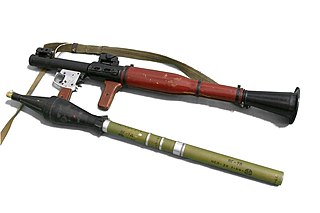
A rocket-propelled grenade (RPG) is a shoulder-fired missile weapon that launches rockets equipped with an explosive warhead. Most RPGs can be carried by an individual soldier, and are frequently used as anti-tank weapons. These warheads are affixed to a rocket motor which propels the RPG towards the target and they are stabilized in flight with fins. Some types of RPG are reloadable with new rocket-propelled grenades, while others are single-use. RPGs are generally loaded from the front.

A shaped charge is an explosive charge shaped to form an explosively formed penetrator (EFP) to focus the effect of the explosive's energy. Different types of shaped charges are used for various purposes such as cutting and forming metal, initiating nuclear weapons, penetrating armor, or perforating wells in the oil and gas industry.

Armour-piercing ammunition (AP) is a type of projectile designed to penetrate either body armour or vehicle armour.

High-explosive anti-tank (HEAT) is the effect of a shaped charge explosive that uses the Munroe effect to penetrate heavy armor. The warhead functions by having an explosive charge collapse a metal liner inside the warhead into a high-velocity explosively formed penetrator (EFP) jet; this is capable of penetrating armor steel to a depth of seven or more times the diameter of the charge. The EFPs jet effect is purely kinetic in nature; the round has no explosive or incendiary effect on the target.

A shell, in a military context, is a projectile whose payload contains an explosive, incendiary, or other chemical filling. Originally it was called a bombshell, but "shell" has come to be unambiguous in a military context. Modern usage sometimes includes large solid kinetic projectiles that is properly termed shot. Solid shot may contain a pyrotechnic compound if a tracer or spotting charge is used.
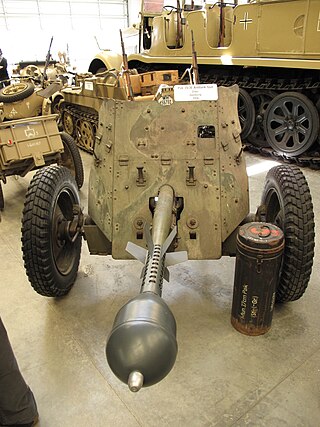
The Stielgranate 41 was a German shaped charge, fin-stabilized shell, used with the 3.7 cm Pak 36 anti-tank gun to give it better anti-tank performance.
During the Second World War, the Luftwaffe developed a series of unguided rocket-propelled armor-piercing bombs. The three main types were the PC 500 Rs, PC 1000 Rs, and PC 1800 Rs. PC from Panzersprengbombe Cylindrisch the number from the approximate weight of the bomb in kilograms, and Rs meaning rocket propelled. These bombs were intended to be used against armored ships or similar targets. The purpose of the rocket propulsion was to increase the terminal velocity of the bomb and aid penetration.

The Gewehr-Panzergranate was a shaped charge rifle grenade that was developed by Germany and used by the Wehrmacht during World War II.

The Große Gewehr-Panzergranate was a shaped charge rifle grenade that was developed by Germany and used by the Wehrmacht during World War II.

The Gewehr-Granatpatrone 40 or GGP/40 for short was a shaped charge rifle grenade used by German forces during the Second World War. It was originally developed for Luftwaffe Fallschirmjäger units to provide them with a light and portable anti-tank weapon.

The Panzerwurfkörper 42 was a HEAT grenade that was developed by Germany and used by the Wehrmacht during World War II. The Panzerwurfkörper 42 was designed to be fired from a Leuchtpistole or flare gun in English.

The Sprengpatrone or "explosive cartridge" in English was a rifle grenade that was developed by Germany and used by the Wehrmacht during World War II. The Sprengpatrone was designed to be fired from a Kampfpistole flare gun.
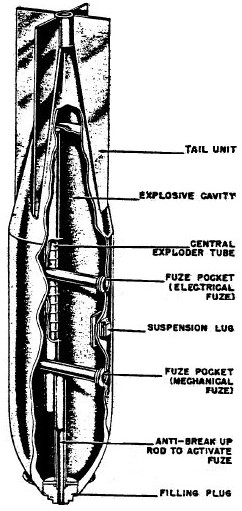
The SB 2500 (Spezialbombe) was a luftmine or aerial mine in English used by the Luftwaffe during World War II.

The SD 50 or thick walled explosive bomb in English was a fragmentation bomb used by the Luftwaffe during World War II.

The SD 70 or thick walled explosive bomb in English was a fragmentation bomb used by the Luftwaffe during World War II.
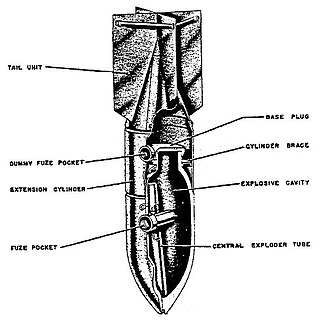
The SD 250 or thick walled explosive bomb in English was a fragmentation bomb used by the Luftwaffe during World War II.
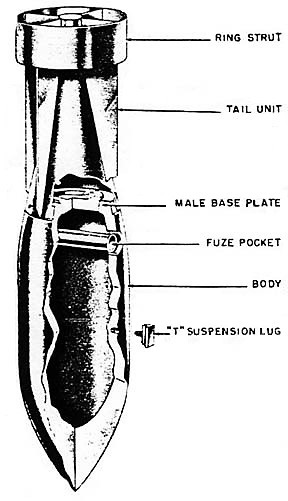
The PC 500 or cylindrical armor-piercing explosive bomb in English was a series of armor-piercing bombs used by the Luftwaffe during World War II.
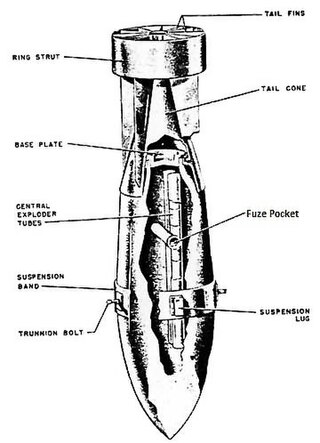
The PC 1000 or cylindrical armor-piercing explosive bomb in English was an armor-piercing bomb used by the Luftwaffe during World War II.

The PC 1400 or cylindrical armor-piercing explosive bomb in English was an armor-piercing bomb used by the Luftwaffe during World War II.

The PC 1600 or cylindrical armor-piercing explosive bomb in English was an armor-piercing bomb used by the Luftwaffe during World War II.



















